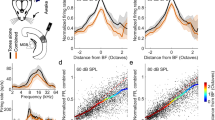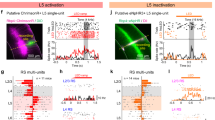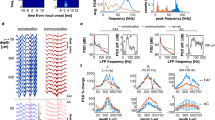Abstract
Auditory signals are transmitted from the inner ear through the brainstem to the higher auditory regions of the brain. Neurons throughout the auditory system are tuned to stimulus frequency, and in many auditory regions are arranged in topographical maps with respect to their preferred frequency. These properties are assumed to arise from the interactions of convergent and divergent projections ascending from lower to higher auditory areas1; such a view, however, ignores the possible role of descending projections from cortical to subcortical regions2,3,4,5,6,7,8,9,10. In the bat auditory system, such corticofugal connections modulate neuronal activity to improve the processing of echo-delay information11,12, a specialized feature. Here we show that corticofugal projections are also involved in the most common type of auditory processing, frequency tuning. When cortical neurons tuned to a specific frequency are inactivated, the auditory responses of subcortical neurons tuned to the same frequency are reduced. Moreover, the responses of other subcortical neurons tuned to different frequencies are increased, and their preferred frequencies are shifted towards that of the inactivated cortical neurons. Thus the corticofugal system mediates a positive feedback which, in combination with widespread lateral inhibition, sharpens and adjusts the tuning of neurons at earlier stages in the auditory processing pathway.
This is a preview of subscription content, access via your institution
Access options
Subscribe to this journal
Receive 51 print issues and online access
$199.00 per year
only $3.90 per issue
Buy this article
- Purchase on Springer Link
- Instant access to full article PDF
Prices may be subject to local taxes which are calculated during checkout



Similar content being viewed by others
References
Suga, N. Cortical computational maps for auditory imaging. Neural Networks 3, 3–21 (1990).
Huffman, R. F. & Henson, O. W. J The descending auditory pathway and acousticomotor system: connections with the inferior colliculus. Brain Res. 15, 295–323 (1990).
Andersen, R. A. et al. The topographic organization of corticocollicular projections from physiologically identified loci in the AI, AII, and anterior auditory cortical field of the cat. J. Comp. Neurol. 191, 479–494 (1980).
Herbert, H. et al. Topography of projections from the auditory cortex to the inferior colliculus in the rat. J. Comp. Neurol. 304, 103–122 (1991).
Massopust, L. C. J & Ordy, J. M. Auditory organization of the inferior colliculus in the cat. Exp. Neurol. 6, 465–477 (1962).
Andersen, P. et al. Corticofugal facilitation of thalamic transmission. Brain Behav. Evol. 6, 170–184 (1972).
Ryugo, D. K. & Weinberger, N. M. Corticofugal modulation of the medial geniculate body. Exp. Neurol. 51, 377–391 (1976).
Mitani, A. et al. Effects of simulation of the primary auditory cortex upon colliculogeniculate neurons in the inferior colliculus of the cat. Neurosci. Lett. 42, 185–189 (1983).
Sun, X. et al. Corticofugal influences on the responses of bat inferior colliculus to sound stimulation. Brain Res. 495, 1–8 (1989).
Villa, A. P. E. et al. Corticofugal modulation of the information processing in the auditory thalamus of the cat. Exp. Brain Res. 86, 506–517 (1991).
Suga, N. et al. in Active Hearing (eds Ottoson, A. F. D. & Ulfendahl, M.) 13–30 (Pergamon, London, (1995)).
Yan, J. & Suga, N. Corticofugal modulation of time-domain processing of biosonar information in bats. Science 273, 1100–1103 (1996).
Johnson, R. A. et al. Detection of insect wing beats by the bat, Pteronotus parnellii. J. Acoust. Soc. Am. 55, S53 (1974).
Goldman, L. J. & Henson, O. W. J Prey recognition and selection by the constant frequency bat, Pteronotus p. parnellii. Behav. Ecol. Sociobiol. 2, 411–419 (1977).
Suga, N. et al. Peripheral specialization for fine analysis of Doppler-shifted echoes in the auditory system of the “CF-FM” bat Pteronotus parnelli. Exp. Biol. 63, 161–192 (1975).
Suga, N. & Jen, P. H. S. Disproportionate tonotopic representation for processing species-specific CF-FM sonar signals in the mustahced bat auditory cortex. Science 194, 542–544 (1976).
Suga, N. & Manabe, T. Neural basis of amplitude-spectrum representation in auditory cortex of the mustached bat. J. Neurophysiol. 47, 225–255 (1982).
Suga, N. & Tsuzuki, K. Inhibition and level-tolerant frequency-tuning curves in the auditory cortex of the mustached bat. J. Neurophysiol. 53, 1109–1145 (1985).
Yang, L. et al. GABAergic circuits sharpen tuning curves and modify response properties in the mustached bat inferior colliculus. J. Neurophysiol. 68, 1760–1774 (1992).
Suga, N. et al. Sharpening of frequency tuning by inhibition in the thalamic auditory nucleus of the mustached bat. J. Neurophysiol. 77, 2098–2114 (1997).
Suga, N. Sharpening of frequency tuning by inhibition in the central auditory system: Tribute to Yasuji Katsuki. Neurosci. Res. 21, 287–299 (1995).
Olsen, J. F. thesis, Washington University((1986)).
Winer, J. A. in The Mammalian Auditory Pathway: Neuroanatomy (eds Webster, D. B., Popper, A. N. & Fay, R. R.) 222–410 (Springer, New York, (1992)).
Suga, N. et al. The personalized auditory cortex of the mustached bat: adaptation for echolocation. J. Neurophysiol. 58, 643–654 (1987).
Edeline, J. M. & Weinberger, N. M. Subcortical adaptive filtering in the auditory system: associative receptive field plasticity in the dorsal medial geniculate body. Behav. Neurosci. 105, 154–175 (1991).
Edeline, J. M. & Weinberger, N. M. Associative returning in the thalamic source of input to the amygdala and auditory cortex: receptive field plasticity in the medial division of the medial geniculate body. Behav. Neurosci. 106, 81–105 (1992).
Edeline, J. M. et al. Rapid development of learning-induced receptive field plasticity in the auditory cortex. Behav. Neurosci. 107, 539–551 (1993).
Suga, N. et al. Specificity of combination-sensitive neurons for processing of complex biosonar signals in the auditory cortex of the mustached bat. J. Neurophysiol. 49, 1573–1626 (1983).
Acknowledgements
We thank the Natural Resource Conservation Authority and the Ministry of agriculture of Jamaica for allowing us to collect and export the moustached bats used in our research. We thank S. Kuwada, W. E. ONeill, J. F. Olsen, D. C. Fitzpatrick and A. Kadir for helpful comments.
Author information
Authors and Affiliations
Corresponding author
Rights and permissions
About this article
Cite this article
Zhang, Y., Suga, N. & Yan, J. Corticofugal modulation of frequency processing in bat auditory system. Nature 387, 900–903 (1997). https://doi.org/10.1038/43180
Received:
Accepted:
Issue Date:
DOI: https://doi.org/10.1038/43180
This article is cited by
-
Descending projections to the auditory midbrain: evolutionary considerations
Journal of Comparative Physiology A (2023)
-
Corticothalamic feedback sculpts visual spatial integration in mouse thalamus
Nature Neuroscience (2021)
-
Neural circuits underlying auditory contrast gain control and their perceptual implications
Nature Communications (2020)
-
Optogenetic auditory fMRI reveals the effects of visual cortical inputs on auditory midbrain response
Scientific Reports (2018)
-
Shaping somatosensory responses in awake rats: cortical modulation of thalamic neurons
Brain Structure and Function (2018)
Comments
By submitting a comment you agree to abide by our Terms and Community Guidelines. If you find something abusive or that does not comply with our terms or guidelines please flag it as inappropriate.



